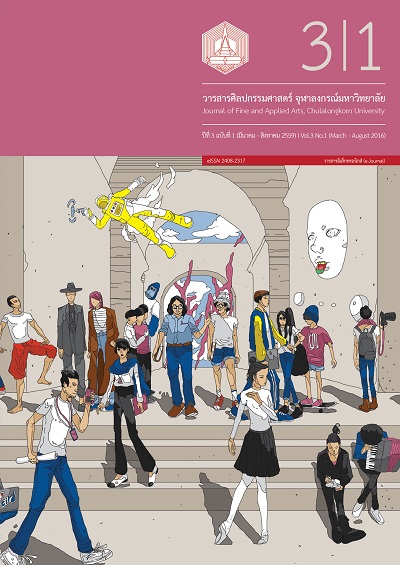วิเคราะห์เดี่ยวซอด้วงเพลงแขกมอญ สามชั้น ทางคุณครูหลวงไพเราะเสียงซอ (อุ่น ดูรยชีวิน) และคุณครูแสวง อภัยวงศ์
Keywords:
เดี่ยวซอด้วง, เพลงแขกมอญ สามชั้น, หลวงไพเราะเสียงซอ (อุ่น ดูรยชีวิน), แสวง อภัยวงศ์ eywords, Saw Doung solo, Kheak Mon Sam Chan, Laung Phai Rao Sieng Saw (Aun Durayachivin), Sawang ApaiwongAbstract
บทคัดย่อ
งานวิจัยเรื่อง “วิเคราะห์เดี่ยวซอด้วงเพลงแขกมอญ สามชั้น ทางคุณครูหลวงไพเราะเสียงซอ (อุ่น ดูรยชีวิน) และคุณครูแสวง อภัยวงศ์” มีวัตถุประสงค์เพื่อศึกษาบริบทและประวัติความเป็นมาของเดี่ยวซอด้วงเพลงแขกมอญ สามชั้น โครงสร้างทำนองหลัก วิเคราะห์การดำเนินทำนอง กลวิธีพิเศษต่าง ๆ ที่ปรากฏในเพลงเดี่ยวดังกล่าว ศึกษาทางคุณครูหลวงไพเราะเสียงซอ (อุ่น ดูรยชีวิน) และคุณครูแสวง อภัยวงศ์ โดยใช้ระเบียบวิธีวิจัยเชิงคุณภาพ ผลการวิจัยพบว่า ซอด้วงเป็นเครื่องสีของไทย มีบทบาทเป็นผู้นำในวงเครื่องสายไทยประเภทต่าง ๆ บทเพลงที่บรรเลงมีทั้งเพลงหมู่และเพลงเดี่ยว สำหรับเพลงเดี่ยวถือเป็นบทเพลงขั้นสูงของการบรรเลงดนตรีไทย เพลงแขกมอญ สามชั้น เป็นอีกบทเพลงหนึ่งที่มีความสำคัญโดยเฉพาะการนำมาทำเป็นทางเดี่ยวในเครื่องดนตรีประเภทต่าง ๆ รวมถึงซอด้วงด้วย การศึกษาเพลงแขกมอญ สามชั้น ในการเดี่ยวซอด้วงทางคุณครูหลวงไพเราะ (อุ่น ดูรยชีวิน) ซึ่งท่านเป็นศิลปินที่มีชื่อเสียงด้านเครื่องสีมาตั้งแต่สมัยรัชกาลที่ 6 มีบทบาทสำคัญด้านเครื่องสายไทยของกรมศิลปากรและวงการดนตรีไทยอย่างกว้างขวาง และทางคุณครูแสวง อภัยวงศ์ ซึ่งท่านเป็นนักดนตรีเครื่องสายไทยในยุคต่อมามีบทบาทในเรื่องของสำนวนเพลงที่มีความโลดโผน ลักษณะร่วมของทั้ง 2 ทางได้แก่ทั้ง 2 ทางจะเน้นการยึดทำนองเดี่ยวตามโครงสร้างทำนองหลักเป็นส่วนใหญ่ บางทำนองทั้ง 2 ทางใช้กลอนเพลงเดียวกัน ปรากฏการใช้กลอนแบบ “ย้ำเสียง”เหมือนกัน ถ้าเป็นทำนองหลักเดียวกัน ทั้ง 2 ทางจะเปลี่ยนแปลงทางเดี่ยวให้แตกต่างกัน กลวิธีพิเศษที่ร่วมกันได้แก่การเอื้อนทำนองและการสะเดาะคันชัก ลักษณะเฉพาะของแต่ละทางได้แก่ เรื่องการแปรทำนอง ทางคุณครูหลวงไพเราะเสียงซอ ให้มีความพิเศษเรื่องกลอนเพลงที่เรียบ ทางคุณครูแสวง แปรทำนองโลดโผน ใช้เสียงซ้ำกันยาวทั้งบรรทัดโน้ต เรื่องกลวิธีพิเศษ ทางครูหลวงไพเราะใช้กลวิธี “การตบสาย” จำนวนน้อย และไม่ปรากฏการรูดสายเมื่อจะทำการเปลี่ยนช่วงเสียง ทางคุณครูแสวง พบกลวิธีการสีซอแบบ “การตบสาย” เป็นจำนวนมาก ปรากฏการรูดสายเมื่อเปลี่ยนช่วงเสียง เรื่องโครงสร้างเพลงทางคุณครูหลวงไพเราะเสียงซอ ท่อน 2 ทั้งเที่ยวโอดและเที่ยวพัน บรรเลงครบทั้ง 6 จังหวะหน้าทับ ทางคุณครูแสวง อภัยวงศ์ ท่อน 2 เที่ยวโอดบรรเลง 3 จังหวะหน้าทับ แต่เที่ยวพันบรรเลง 6 จังหวะหน้าทับ
Abstract
This research aimed to study contexts, history and melody structure of Kheak Mon Sam Chan in Saw Doung solo, to analyze the performing and special techniques used in the solo, and to study performing techniques of Kru Laung Phai Rao Sieng Saw (Aun Durayachivin) and Kru Sawang Apaiwong through the qualitative research methodology. The result of the study presented that Saw Doung is Thai stringed instrument used as the leading sound of Thai stringed band; it is used both in the group and the solo performance. The solo is known as the professional level of traditional Thai music performance. Kheak Mon Sam Chan is one of the famous songs that is performed in various instrument solos as well as in Saw Doung solo. The study also showed the comparison of the solo techniques between Kru Laung Phai Rao Sieng Saw (Aun Durayachivin) and Kru Sawang Apaiwong. Kru Laung Phai Rao Sieng Saw had been a famous Thai stringed musician since the reign of King Rama VI and he also played a very important role in the field of stringed instrument in the Fine Arts Department and traditional Thai music circle. Kru Sawang is a famous Thai stringed musician in the next era who is famous for stirring melody performing. The similarities of the two musicians’ performing techniques were that both emphasized on the solo of the main melody structure strictly, and used the “repeated melody” technique in the same songs. Besides, when they performed the same main melody structure, they both changed the solos with different techniques such as drawing out the note and jerking the bow. The differences were melody changing technique, some special techniques, and song structure. Kru Laung Phai Rao Sieng Saw performed with smooth melody changing, but Kru Sawang showed stirring melody changing by using repeated note sound. The special techniques used by Kru Laung Phai Rao Sieng Saw were “slap-string” technique—used a few times, and the rub-string technique was not found in his performance; whereas, Kru Sawang frequently use the “slap-string” technique and used the rub-string technique when changing note ranges. About the song structure, Kru Laung Phai Rao Sieng Saw performed the song in part two—both Oad and Pun parts—with all six Na Tab beats; meanwhile, Kru Sawang performed the Oad part with three Na Tab beats but six Na Tab beats in Pun parts.
Downloads
Published
Issue
Section
License
ลิขสิทธิ์ของบทความเป็นของเจ้าของบทความ บทความที่ได้รับการตีพิมพ์ถือเป็นทัศนะของผู้เขียน
กองบรรณาธิการไม่จำเป็นต้องเห็นด้วยและไม่รับผิดชอบต่อบทความนั้น






